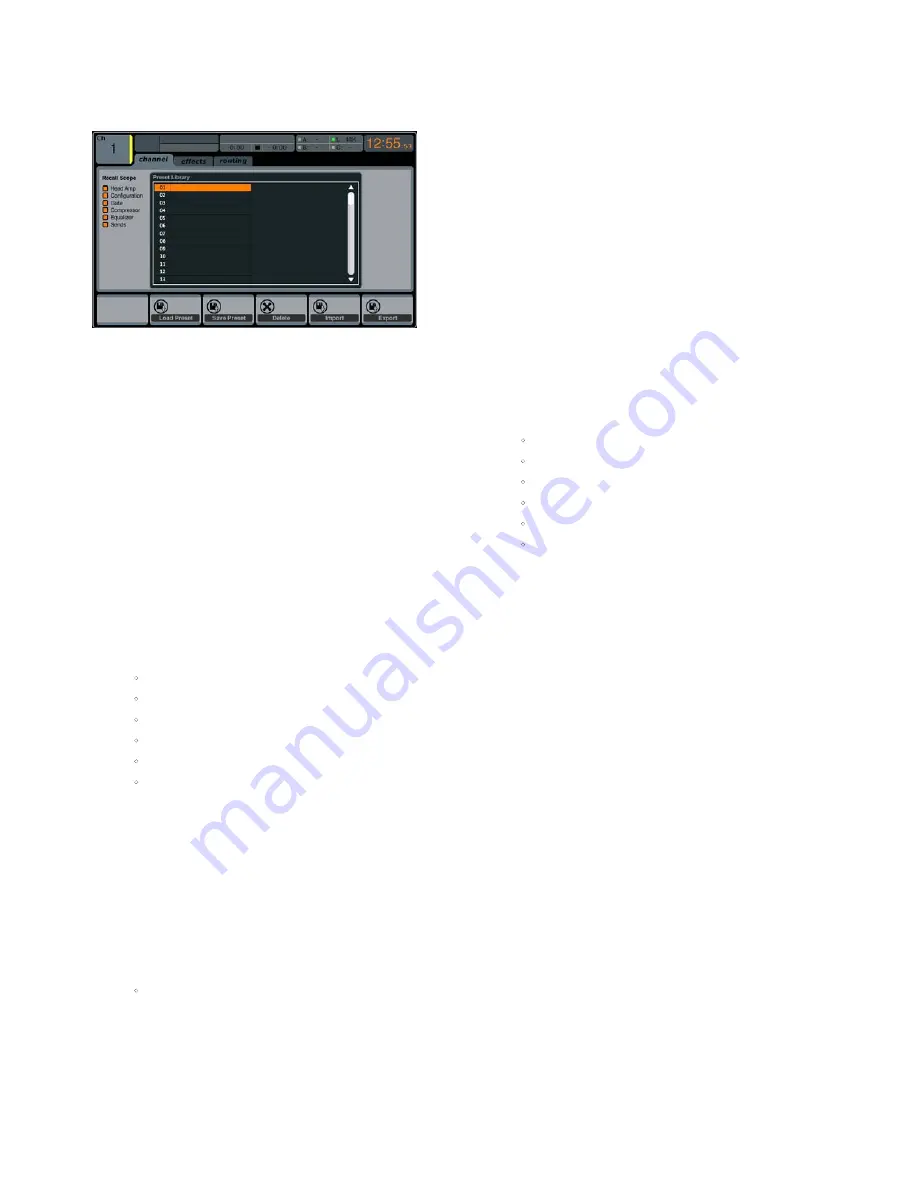
32
DIGITAL RACK MIXER M32R User Manual
2.4 Library
The
LIBRARY
screen allows loading and saving of commonly used setups for the
channel inputs, effects processors and routing scenarios.
The
LIBRARY
screen contains the following separate tabs:
channel
: This tab allows the user to load and save commonly used
combinations of the channel DSP effects.
effects
: This tab allows the user to load and save commonly used
effects processor presets.
routing
: This tab allows the user to load and save commonly used
signal routings.
channel
The
LIBRARY
screen’s
channel
tab allows you to load and save commonly used
combinations of the channel DSP effects. For example, once you have dialled
in a combination of EQ and compression that works well for a particular singer,
you can save the channel DSP chain as a preset for later recall.
To adjust the various settings on the
channel
tab, perform the
following steps:
1. Adjust the first push encoder to select which specific elements of the
input channel can be recalled when loading an input channel preset.
Choices include:
•
Head Amp (Microphone Preamplifier)
•
Configuration
•
Gate
•
Compressor
•
Equalizer
•
Sends.
2. Tap the first encoder to turn the currently selected element on or off in
the recall list.
3. Adjust the second encoder to scroll among a list of input
channel presets.
4. Tap the second encoder to load the currently highlighted preset and
make it active on the currently selected console channel.
5. Adjust the third encoder to scroll among a list of channel preset slots to
save the current state of the currently selected console channel.
6. Tap the third encoder to save the currently selected channel’s state to
the currently selected preset slot.
•
When the third encoder is tapped, a preset naming screen appears
Adjust and tap encoders 4-6 to apply a custom name to the preset
before saving it, then tap the sixth encoder to complete the
save process.
7. Tap the fourth encoder to delete a preset from the currently highlighted
preset slot.
effects
The
LIBRARY
screen’s
effects
tab allows you to load and save presets for the
various onboard effects processors.
To adjust the various settings on the
effects
tab, perform the following steps:
Adjust the first push encoder to select which of the eight effects slots to load or
save a preset.
As you navigate among the eight effects slots the specific effect processor loaded
into each slot will display on the screen as both a name and an icon.
To save and load presets, as well as import/export them, follow the same
procedure as detailed in the
LIBRARY
screen
channel
tab.
routing
The
LIBRARY
screen’s
routing
tab allows you to load and save presets of the
M32R’s signal routings. This can be useful for repeating specific routing scenarios
that occur over and over on a regular basis, such as when using the console for a
weekly club gig or worship service.
To adjust the various settings on the
routing
tab, perform the
following steps:
1. Adjust the first push encoder to select which specific console signal
paths will be recalled when loading a routing preset. Choices include:
•
Channel Inputs
•
Analog Out
•
Auxiliary Out
•
P16 (ULTRANET) Out
•
Card Out
•
AES50 Out.
2. Tap the first encoder to turn the currently selected element on or off in
the recall list.
3. To save and load presets, as well as import/export them, follow the
same procedure as detailed in the
LIBRARY
screen
channel
tab.
2.5 Effects
The
EFFECTS
screen controls various aspects of the eight internal effects
processors. On this screen the user can select specific types of effects for the
eight internal processors, configure their input and output paths, monitor their
levels, and adjust the various effect parameters.
The first four slots can be Insert and Side-Chain effects, and the slots five to eight
are Insert only. Additionally these slots can only hold some effects excluding
reverbs and other power-intensive effects. They also have different selections for
the input sources.
The
EFFECTS
screen contains the following separate tabs:
home
: The home tab provides a general overview for all eight effects
processors, displaying what effect has been inserted in each of the eight
slots, as well as displaying input/output paths for each slot, and the I/O
signal levels.
fx1-8
: These eight duplicate screens display all relevant data for
the right separate effects processors, allowing the user to adjust all
parameters for the selected effect.






























